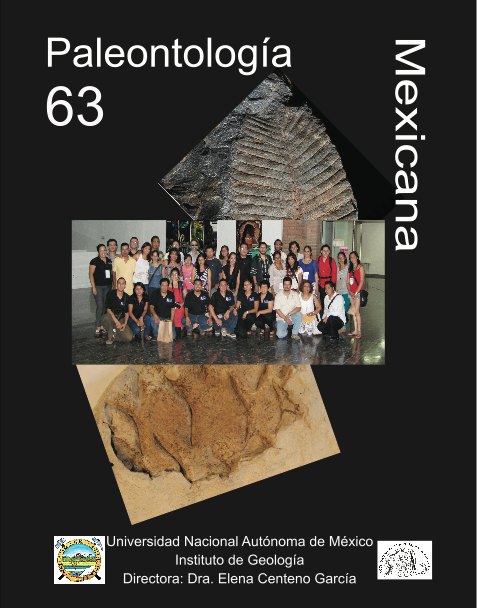Inference of the Paleoclimate of the Miocene formation in Ixtapa Chiapas, using the foliar physiognomy of fossils
Main Article Content
Abstract
The relationship between vegetation and climate in the fossil represents a good proxy paleoclimatic, and as a basis or principle of these studies found a close correlation with biological actualism. The leaves are the most susceptible organ of plants because respond to the environment in which they grow. Studies have been conducted to demonstrate the correlation between climate, genes and phenotype, this correlation is reflected in the morphology of the leaf. Under this premise the goal of this work is to infer the climatic parameters under which Miocene flora developed Ixtapa, Chiapas. Based on leaf characteristics were recognized 126 morphotypes were analyzed with the CLAMP methodology that allows comparison to the fossil flora with 173 existing sites. The study suggests that in Ixtapa, Chiapas, during the late Middle Miocene (12.53 to 15.25 million years), appeared had a semi-cold wet weather. This result, compared with climates that are described today in Mexico, suggests that the region probably developed in a similar Cloud Forest vegetation. The dominant physiognomy of fossil leaves includes size microphyll entire margin, acute form of the base and acute apex. Among the 126 different morphotypes described two related to Moraceae and Sapindaceae families. Such studies represent an opportunity to understand the relationship of climate and environmental scenarios as selectors vegetation.
Article Details

This work is licensed under a Creative Commons Attribution-NonCommercial-NoDerivatives 4.0 International License.
References
Calvillo-Canadell L, Cevallos-Ferriz S.R.S, Rico-Arce L. 2009. Miocene Hymenaea flowers preserved in amber from Simojo-vel de Allende, Chiapas, Mexico. Review of Palaeobotany and Palynology 160, 3-4:126-134.
Castañeda-Posadas C., 2007. Modelo paleoclimático basado en los caracteres anatómicos de la madera de las rocas miocénicas de las regiones de Panotla, Tlaxcala y Chajul Chiapas. Tesis de maestría. Posgrado en Ciencias Biológicas. Universidad Autónoma de México. México, D.F. 160 p.
Cevallos-Ferriz, S.R.S. y González-Torres, E. A. 2005. Geological setting and phytodiversity in México En: Vega F. J., Nyborg, T.G., Perrilliat, M.C., Montellanos Ballesteros, M., Cevallos-Ferriz, S.R.S y Quiroz-Barroso, S.A. Studies on Mexican Paleontology. Springer. Netherlands.
CONABIO, 2010. El Bosque Mesófilo de Montaña en México: Amenazas y Oportunidades para su Conservación y Manejo Sostenible. Comisión Nacional para el Conocimiento y Uso de la Biodiversidad. México D.F., México. 197 p.
Ferrusquía-Villafaranca, I., 1996. Contribución al conocimiento geológico de Chiapas. El área Ixtapa-Soyaló. Instituto de Geología de la Universidad Nacional Autónoma de México, Boletín 109:1-135.
García-Miranda, E., 1986. Apuntes de Climatología. Universidad Nacional Autónoma de México. México D.F. 155p.
García, R.J.M., 1988. Los recursos hídricos superficiales. Colección de Estudios Altoaragoneses. Huesca. 2: 224p.
Leaf Architecture Working Group. 1999. Manual of leaf architecture: morphological description and categorization of dicotyledonous and net-veined monocotyledonous angiosperms. Smithsonian Institution, Washington, D.C. 189p.
Martínez-Hernández, E., 1992. Caracterización ambiental del terciario del terciario de la región de Ixtapa, del estado de Chiapas un enfoque palinoestratigráfico, Instituto de Geología. Universidad Nacional Autónoma de México. México D.F. 10(1): 54-64.
Melendez A., 1999. Indicios Geológicos de los cambios climáticos a lo largo de los mil últimos millones de años. Revista Real Academia de las Ciencias Exactas Físicas Naturales. España. 93(1).
Peralta, M.E., 2009, Arquitectura Foliar de hojas fósiles de Ixtapa, Chiapas, México. Tesis de Licenciatura. Facultad de Ciencias, Universidad Nacional Autónoma de México. 78p.
Rzedowski, J., 1966. Datos biográficos de Faustino Miranda. Ciencia. México, 24: 5- 6, 171-175.
Rzedowski, J., 1993. Diversity and origins of the Phanerogamic flora of Mexico. In: Hernández-Damian Ana Lilia, 2010. Diversidad foliar en el Mioceno de San Esteban Tizatlán Tlaxcala. Tesis de Licenciatura. Facultad de Ciencias. Universidad Nacional Autónoma de México. 69p
Spicer, R.A., et al., 2004. The Foliar Physiognomic Record of Climatic Conditions During Dormancy: CLAMP and the Cold Month Mean Temperature. Journal of Geology. 112: 685-702.
Spicer, R.A., 2000. Leaf Physiognomy and Climate Change. In: Culver SJ and Rawson P (ed) Biotic Response to Global change: the Last 145 Million Years. Cambridge University Press, Cambridge, 244-264p.
Spicer, R. A., Bera, S., De Bera, S., Spicer, T. E.V., Srivastava, G., Mehrotra, R., Mehrotra, N., and Yang, J. 2011 Why do foliar physiognomic climate estimates sometimes differ from those observed? Insights from taphonomic information loss and a CLAMP case study from the Ganges Delta. Palaeogeography, Palaeoclimatology, Palaeoecology 302: 381-395.
Velasco de Leon, P.M. 1999. Estudio Paleoecológico de una comunidad del Terciario en el Estado de Puebla. Tesis de Doctorado, Instituto de Geología Universidad Nacional Autónoma de México. México D.F. 87 p.
Wolfe, J.A., 1971. Tertiary climatic fluctuations and methods of analysis of Tertiary floras: Palaeogeography, Palaeoclimatology, Palaeoecology 9: 27–57.
Wolfe, J.A., 1978. A paleobotanical interpretation of Tertiary climates in the Northern Hemisphere. Am. Sci. 66: 694-703.
Wolfe, J.A., 1993. A method of obtaining climatic parameters from leaf assemblages. U.S. Geological Survey Bulletin, 2040: 1-71.
Wolfe, J.A., 1995. Paleoclimatic estimates from tertiary leaf assemblages. Ann. Rev. Earth and Planetary Sc., 23: 119–142.
DOCUMENTOS ELECTRÓNICOS
Spicer, R.A., 2011. Clamp on line. (Consultado 20 julio 2011).
Spicer, R.A., 2011 Clamp on line. http://clamp.ibcas.ac.cn/ (Consultado septiembre 2011 a Julio 2012).
Página oficial de Chiapas. (Consultado abril 2011).
CONABIO. Tipos de vegetación. http://www.conabio.gob.mx/mapaservidor/incendios/modis/tablas2004/mayo/diurnas/terra/paso1/t1.040511.1623.html (Consultado 15 mayo 2011).
